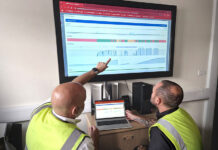The performance of food inspection machines will be affected by product characteristics and density as they pass through the aperture. Phil Brown, European managing director of Fortress Technology and Sparc Systems examines x-ray and metal detectors to explain why.

THERE are two distinct components to metal detection: magnetic permeability and conductivity.
Most food products will leave a ‘fingerprint’ that combines elements of both, though the overriding component is likely to be conductivity.
Metals also exhibit telltale combinations of both types of effect. For example, the majority of ferrous metals display stronger magnetic permeability, while non-ferrous metals will signal higher conductivity.
Indicators for stainless steel, on the other hand, can easily be swamped by product effect.
With an x-ray machine, light waves pass through the product to be inspected. Because of this, products of differing densities impact an x-ray’s performance.
To put this into context, Phil uses a box of cereal as an example: “Although an x-ray machine will be calibrated for the product’s total density, cereal ingredients, raisins and bran for example, have variable densities. Speckles of raisin will be quite high, the bran low and the box they’re in, the same density. As the x-ray is measuring the collective density, if there’s a contaminant in the box and the machine lands on a low density bran flake, it may not detect the sample in the same way it would when landing on a higher density raisin.”
Similarly, there will be a different response if an odd shaped piece of metal passes through a machine in different directions.
This is why spheres are used to test a metal detector – it reflects the same amount of signal no matter where it’s pointing. Yet, flatten out the metal or roll it into a needle or wire shape, there’ll be a significant difference in signal, depending on how it passes through.
This is due to the physics of how it’s breaking the lines in the field.
The general rule is ‘if any of the dimensions are less than the detectable metal’s sphere size, the machine may have trouble detecting it’.
Depending on the orientation in which it passes through, a bigger signal than the sphere may occur.
With an x-ray, the detection system – usually diodes – is underneath the light beam. If the product is very thin at its length and edge and small across the belt, even if the density is quite high, it may not be detected.
Equally, if it’s very thin and flat, such as stainless steel and ferrous metal blade shapes, the total density may be too small to detect.
In these scenarios, a metal detector is the top performer.
And when it comes to drilling down to detail, the key detection factor is the size of the product in relation to the machine’s aperture.
A metal detector’s abilities weaken as the aperture gets bigger, so there’s no problem with a small detector, i.e. pharmaceutical size down to 0.15mm, or larger inspection ranges between 2-4mm.
With an x-ray machine, the less distance between the light beam and the detection point, the denser the field, resulting in lower rates of small contaminant pick up.
The type of technology being used also impacts detection. Diode rays are typically limited to 0.8mm or 0.4mm.

When looking for metal contaminants of all sizes, particularly low-density metals such as aluminium, a metal detector will outperform an x-ray. Yet, as the aperture size increases, the x-ray races ahead, picking up denser metals such as stainless steel.
The larger the aperture on a metal detector, the larger the product and more power required.
Typically this is only an increase of a few volts, rather than the additional kilovolts needed on an x-ray machine.
If an x-ray is handling larger products, larger apertures and more power will be required. Where something bulky is passing through, such as a 50lb bag of flour or sugar with 6-8 inches of reasonably dense material, more power will be required to process it.
On the plus side, these homogenous products have few density variations, so detection is relatively easy.
Phil ends: “Metal detectors and x-rays are complimentary technologies. If, after product risk analysis, you consider one is necessary, have both. A metal detector should be a given and an x-ray machine added to the line if there are specific needs, such as potential contaminants that won’t detect well.”












